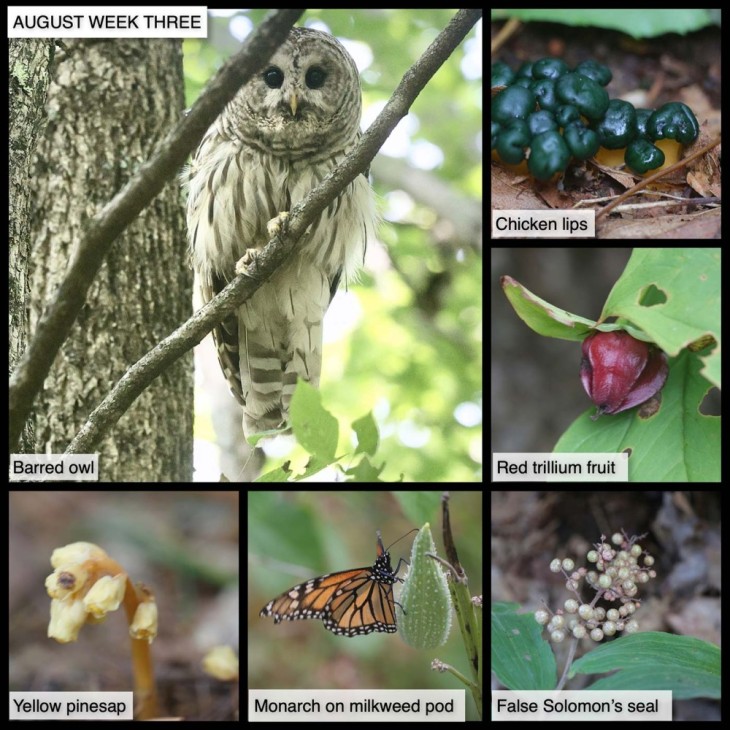This Week in the Woods, we were very surprised when a barred owl alit on a branch just a few feet from us, on a frequently-walked trail. It called once, then swiveled its head to track something (prey?) farther up the trail, and flew away. Here’s an early 2021 Outside Story article about the species by Lee Emmons, and here’s the most recent entry to our bi-weekly “What in the Woods is That?” game, featuring a photo by Sandy Dannis of a barred owl holding a…? Take a look and submit your guess.
Here are some other nature sights this week (clockwise):
What are those weird green blobs on the forest floor? They’re Leotia viscosa, also known as chicken lips. Why someone decided to name a small green mushroom after a part of bird anatomy that does not exist is one of life’s great mysteries, but in any event, you typically find these and other Leotia species popping up from mid-summer to mid-autumn. Here are some other chicken lip images from iNaturalist.
This seems to be a good year for red trillium (wake robin) reproduction, based on the number of the plants’ ruby red fruits we’ve been noticing recently. However, as Laurie Morrissey notes in this Outside Story essay, fruit one year doesn’t mean more flowers the next spring. Instead, “[a]fter a fertilized seed germinates, the plant spends its first summer or two as one tiny leaf.” (Wonky side note: trillium leaves aren’t technically leaves, although they’re widely described as such. They’re bracts. You can read all about it in this U.S. Forest Service post.
It’s berry season for many plants, including false Solomon’s seal. This is a bigger cousin of Canada mayflower, and like that pervasive woodland species, its fruit have an intermediate ripening stage where they resemble speckled jellybeans. Here’s a profile of false Solomon’s seal from Minnesota Wildflowers, which includes photos of the plant’s early summer blooms.
We found this monarch butterfly perched on a developing milkweed pod – a cheering sight! Northern Woodlands has a number of monarch-related articles in our archive. Here’s an Outside Story essay describing a caterpillar raising experience, and a photo from Mary Holland describing monarch caterpillar cannibalism, featured in our Summer 2021 magazine. To explore Holland’s blog of photos and nature notes, go to this link.
Finally, we’ve been seeing an unusual abundance of waxy white ghost plants in the woods, and have also had more-often-than-typical sightings of yellow pinesap. Both species, members of the Monotropa genus, eschew all the hassle of photosynthesis and instead make their living by parasitizing the mycorrhizal fungi that connects with tree roots. Here’s a profile from The Native Plant Trust. Maybe the success of these fungi-dependent plants this summer, is linked to the same growing conditions that produced this year’s bumper crop of mushrooms?
Our thanks to The Bailey Charitable Foundation and the Frank and Brinna Sands Foundation for helping to support this series.
In this difficult period, many of us find joy in observing local nature. This series, launched in April 2020, shares nature photographs taken in the past seven days, or in the same week in 2020, most within 15 miles of the Northern Woodlands office in Lyme, New Hampshire. We hope you enjoy using this grid as a prompt for your own explorations.
What are you seeing in the woods this week? Share your images with us on Facebook, or submit a special photo for possible inclusion in our monthly online Reader Photo Gallery.


